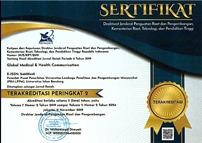Correlation between Length-to-width Ratio of Gallbladder and Gamma-glutamyl Transferase Value in Biliary Atresia
Abstract
Keywords
Full Text:
PDFReferences
Schreiber RA, Barker CC, Roberts EA, Martin SR, Alvarez F, Smith L, et al. Biliary atresia: the Canadian experience. J Pediatr. 2007;151(6):659–65, 665.e1.
Adam A, Dixon AK, Gillard JH, Schaefer-Prokop CM, editors. Grainger & Allison’s diagnostic radiology a textbook of medical imaging. 7th Edition. Warsaw, Poland: Elsevier Ltd.; 2021.
Setyoboedi B, Utomo MT, Prihaningtyas RA, Winahyu AK, Arief S. Tingkat pengetahuan atresia bilier pada bidan di puskesmas Kabupaten Sidoarjo. J Abdi Insani. 2022;9(4):1839–46.
arollo V, Gentile G, Di Piazza A, Marrone G, Milazzo M, Mamone G, et al. The role of ultrasound in the early diagnosis of biliary atresia [Internet]. Vienna, Austria: European Society of Radiology; 2018 [cited 2024 August 10]. Available from: https://dx.doi.org/10.1594/ecr2018/C-1472.
Napolitano M, Franchi-Abella S, Damasio MB, Augdal TA, Avni FE, Bruno C, et al. Practical approach to imaging diagnosis of biliary atresia, Part 1: prenatal ultrasound and magnetic resonance imaging, and postnatal ultrasound. Pediatr Radiol. 2021;51(2):314–31.
Wang G, Zhang N, Zhang X, Zhou W, Xie X, Zhou L. Ultrasound characteristics combined with gamma-glutamyl transpeptidase for diagnosis of biliary atresia in infants less than 30 days. Pediatr Surg Int. 2021;37(9):1175–82.
Sulistio PA, Violetta L, Rahniayu A. Diagnostic value of ultrasound parameter in neonatal biliary atresia based on histopathological results (ultrasound study of triangular cord sign and gallbladder abnormality). Int J Res Publ. 2022;108(1):316–22.
Zhang K, Tang Y, Zheng Z, Tang C, Zhu D, Du Q, et al. Value of gallbladder length-to-width ratio for diagnosis of biliary atresia by correlation with age. Updates Surg. 2023;75(4):915–20.
Sun Y, Dai S, Shen Z, Yang Y, Hong S, Dong R, et al. Gamma-glutamyl transpeptidase has different efficacy on biliary atresia diagnosis in different hospital patient groups: an application of machine learning approach. Pediatr Surg Int. 2022;38(8):1131–41.
Sira MM, Salem TAH, Sira AM. Biliary atresia: a challenging diagnosis. Glob J Gastroenterol Hepatol. 2013;1(1):24–35.
Zhou W, Zhou L. Ultrasound for the diagnosis of biliary atresia: from conventional ultrasound to artificial intelligence. MDPI. 2022;
Silveira TR, Salzano FM, Donaldson PT, Mieli-Vergani G, Howard ER, Mowat AP. Association between HLA and extrahepatic biliary atresia. J Pediatr Gastroenterol Nutr. 1993;16(2):114–7.
Black AJ, Lu DY, Yefet LS, Baird R. Sex differences in surgically correctable congenital anomalies: a systematic review. J Pediatr Surg. 2020;55(5):811–20.
Nio M, editor. Introduction to biliary atresia. Berlin: Springer Nature; 2021.
Choochuen P, Kritsaneepaiboon S, Charoonratana V, Sangkhathat S. Is “gallbladder length-to-width ratio” useful in diagnosing biliary atresia? J Pediatr Surg. 2019;54(9):1946–52.
Tang KS, Huang LT, Huang YH, Lai CY, Wu CH, Wang SM, et al. Gamma-glutamyl transferase in the diagnosis of biliary atresia. Acta Paediatr Taiwanica. 2007;48(4):196–200.
Kotb MA. Review of historical cohort: ursodeoxycholic acid in extrahepatic biliary atresia. J Pediatr Surg. 2008;43(7):1321–7.
Robles-Diaz M, Garcia-Cortes M, Medina-Caliz I, Gonzalez-Jimenez A, Gonzalez-Grande R, Navarro JM, et al. The value of serum aspartate aminotransferase and gamma-glutamyl transpetidase as biomarkers in hepatotoxicity. Liver Int. 2015;35(11):2474–82.
Simental-Mendía M, Sánchez-García A, Simental-Mendía LE. Effect of ursodeoxycholic acid on liver markers: a systematic review and meta-analysis of randomized placebo-controlled clinical trials. Br J Clin Pharmacol. 2020;86(8):1476–88.
Weng Z, Zhou W, Wu Q, Ma H, Fang Y, Dang T, et al. Gamma-glutamyl transferase combined with conventional ultrasound features in diagnosing biliary atresia: a two-center retrospective analysis. J Ultrasound Med. 2022;41(11):2805–17.
Kong F, Dong R, Chen G, Sun S, Yang Y, Jiang J, et al. Progress in biomarkers related to biliary atresia. J Clin Transl Hepatol. 2024;12(3):305–15.
pISSN 2301-9123 | eISSN 2460-5441
Visitor since 19 October 2016:
Global Medical and Health Communication is licensed under a Creative Commons Attribution-NonCommercial-ShareAlike 4.0 International License.






























.png)
_(1).png)
_(1).jpg)
